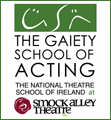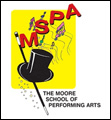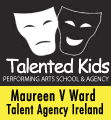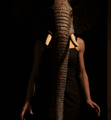We spoke with director-producer Táine King to discuss her latest short film The Wilde Sisters, as well as her background in art direction.
Over the past decade, Táine King has collaborated with world-renowned directors, actors, and producers. As well as directing and producing her own work, King has worked in art direction, most notably collaborating with director Ridley Scott for the past four years. Her journey with Scott began with the mediaeval drama The Last Duel shot in Ireland in 2019 and continued through projects like House of Gucci and Napoleon. The latter, starring Joaquin Phoenix, is nominated for three Academy Awards, including Best Achievement in Production Design.
King’s upcoming short film The Wilde Sisters is set in 1871 Monaghan, currently in post-production, and slated for a 2024 festival circuit release.
To overcome funding challenges, King utilised crowdfunding and garnered support from industry colleagues to bring this period drama to life. Notably, the film has already garnered attention, being selected for the Cinesud Screen Talent European Writer's Room development scheme and receiving an Honourable Mention award in the Catalyst International Film Festival short screenplay competition.
King's previous work has gained recognition at many film festivals globally. In 2015, her inaugural fashion film, Embryo, screened at both the Milan Fashion Film Festival and Berlin Fashion Film Festival. The Holy Ghost, which King directed for Repeal the 8th, earned her acclaim at Berlin Commercial in 2019, securing her place in the Best Emerging Talent category. Then Táine went on to be nominated by the 1.4 Directors Awards in London for an ‘On the Cusp of Greatness’ award for directing.
In 2020, King’s short documentary Making Tom earned her a nomination for Best Female Director at the Cork Indie Film Festival.
We sat down with Táine King to discuss directing her latest short film The Wilde Sisters, working with Ridley Scott, and how her background in art direction influences her approach to filmmaking.
IFTN: What can you tell us about your short film The Wilde Sisters?
TÁINE: “The Wilde Sisters is a short film that delves into the untold story of Oscar Wilde's two half-sisters, Mary and Emily, who lived a hidden life in County Monaghan.”
“The story begins on that fateful night in Drummaconnor House. Mary, in a moment of joy and abandon, went for one last dance around the room. Her crinoline dress caught an ember by the fireplace, leading to a devastating fire. In a desperate attempt to save her sister, Emily ran to help her. however Emily's dress also ignited, resulting in a heartbreaking and tragic end for both.”
“We take the audience into the afterlife, portraying Mary and Emily stuck in purgatory. The surreal setting allows us to explore the emotional aftermath of the sisters' demise. Surprisingly, Mary appears intoxicated, suggesting the unresolved nature of their passing, while Emily grapples with the painful truth: their father, Sir William Wilde, covered up their identity and changed their names so the press would not be suspicious about who these two women were.”
“The film delves into themes of denial, guilt, and the consequences of secrets. It becomes a journey of self-discovery and reconciliation as Emily confronts the concealed truth that has kept them trapped in purgatory.”
“In essence, The Wilde Sisters is more than a historical reimagining. It's a poignant reflection on the unspoken aspects of familial relationships and the enduring power of truth, even in the afterlife.”
IFTN: What drew you to the story of Emily and Mary Wilde?
TÁINE: “Firstly, there's the historical aspect, the hidden lives of Oscar Wilde's half-sisters in County Monaghan, a chapter that few are aware of. Uncovering these lesser-known stories allows us to shine a light on overlooked aspects of history, which all too often seem to be women's stories. I wanted to breathe life into characters who have long been relegated to the shadows.”
“The tragic night at DrumaconnorHouse added another layer of complexity. The juxtaposition of the lively party atmosphere with the devastating turn of events intrigued me. It's a moment frozen in time, ripe for exploration, and it serves as a poignant reminder of how quickly joy can turn to tragedy.”
“What truly compelled me to tell their story, however, was the aftermath, the unresolved emotions and the impact of a father's decision to conceal the truth. Emily and Mary, trapped in purgatory, symbolise the consequences of suppressed secrets and the profound effect it can have on the human spirit.”
“Ultimately, as a storyteller, I was drawn to the challenge of bringing these complex emotions to life on screen and shedding light on a narrative that, despite its historical roots, is timeless in its exploration of human experience.”
IFTN: How did you go about funding the project?
TÁINE: “Securing funding for The Wilde Sisters was a collaborative effort that involved leveraging multiple sources of support. Going for funding to different bodies and pitching a period short set in 1871 where I set two women on fire was not met with much hope of accomplishment as it was just deemed too ambitious for a short. So I opted to explore crowdfunding as one avenue to fund the project. We launched a GoFundMe campaign to reach a wider audience and involve people who were passionate about storytelling, history, and supporting independent filmmaking. The response from our crowdfunding campaign was truly heartening.”
“Additionally, we were fortunate to receive support from Creative Monaghan, Creative Communities and Monaghan County Council. Their recognition of the cultural and historical significance of the project allowed us to further enhance the post-production quality and ensure that we could do justice to the Wilde sisters' story and bring the story to film festivals.”
“But it really could not have been made with all of the people I work with within the film industry. The film industry is built on strong relationships, and I am grateful for the incredible support from my colleagues. What struck me the most was their proactive approach in asking, 'What can we do to help?' It wasn't just about financial backing, it was a collective effort to contribute skills, resources, and expertise. My industry colleagues became an integral part of the filmmaking process. Their belief in the project went beyond a professional collaboration; it became a shared passion to bring the Wilde sisters' story to life. It's an experience that has reaffirmed my faith in the strength of our film community and the power of coming together to help independent filmmaking.”
IFTN: How did your experience as an art director influence your approach to directing The Wilde Sisters?
TÁINE: “My tenure as an art director, particularly my working with Ridley Scott over the past four years on projects such as The Last Duel, House of Gucci, and Napoleon, has not only sharpened my visual storytelling skills but has also deepened my understanding of the symbiotic relationship between sets, environments, and actor performances.”
“Having crafted environments that transport actors to specific time periods and emotional landscapes, (and on set with Ridley sometimes that environment needs to be crafted in ten minutes flat!) I recognise the profound influence a carefully designed set can have on an actor's portrayal of a character.”
“House of Gucci was a good example of this as Lady Gaga used the rooms we designed and the clothes she wore to intensify her character of Patricia. The furniture she moved around, the glass that she drank from, and the car she drove were all integral to how she portrayed her character at different stages of her life. They were not just props or dressing they were tools that helped her tell the story of her character.”
In the case of The Wilde Sisters, the historical accuracy and attention to detail in the set design are pivotal in creating an authentic backdrop for the narrative. These details are not just about visual aesthetics but a deliberate effort to transport both the audience and, crucially, the actors into the immersive environment of that period and help them get the best performance.
"Now, as a director, I see sets as essential partners in the storytelling journey, not just static backdrops. They're dynamic collaborators that bring life and depth to narratives. Transitioning from art director to director, my commitment to creating immersive worlds has only deepened. It's not just about making things visually appealing; it's about actively engaging with the narrative.”
“Recognising sets as active participants allows me to guide actors more effectively, infuse nuanced emotions into the scenes, and ensure that the audience is fully immersed in the cinematic experience.”
IFTN: What is the most challenging aspect of working as a standby art director for Ridley Scott?
TÁINE: “Working as a standby art director for Ridley Scott indeed poses unique challenges, particularly revolving around the imperative for rapid adaptability and thriving in an ever-evolving environment.”
“A standout instance of this rapid decision-making occurred during the filming of Napoleon in the Russian village. Originally the set was not to include a French military camp. We were shooting on an airfield outside of London. It was a huge space and the day before on the other side of the airfield we had been shooting the Russian camp of Tsar Alexander so we had some tents there, but mostly lined out for VFX they were not finished dressed tents, mere markers for the VFX team. The first AD turned up that morning and pulled me aside and said 'So, remember that French camp we said we were never gonna have, well we are going to have one for Napoleon to ride out of, you have 40 minutes until Ridley is in front of the monitors, looking at the cameras, good luck'.”
“With 11 cameras capturing every detail, there was no room for oversight. Coordinating every department, from set decoration to painters and carpenters, we orchestrated a rapid transformation, turning the field into a vivid French camp. Not even the scouts could have put up a camp as quick as that. It was a tough morning, it's a multimillion dollar movie and you don't want to be that person on set holding up the shooting.”
Ridley comes on set and gets in front of the monitors and he begins with his meticulous attention to detail. He directs me to dress each camera shot, creating a visual narrative for each frame. The synergy between his vision and the practical execution by me and other departments is crucial. It's a challenging process, tapping into Ridley's dynamic thinking, but once you sync with his creative rhythm, the experience becomes incredibly exciting. Working on this film was undoubtedly one of the most challenging experiences in my career, especially considering it was my third movie with Ridley. However, witnessing the culmination of our efforts on the big screen during a London screening in November was an incredibly proud moment. “Now, the film has been nominated for an Oscar in the production design category, this adds an extra layer of accomplishment. Being part of an Oscar-nominated art department is a dream that many art directors aspire to but only a fortunate few get to realise. It's a testament to the dedication and hard work of the entire team, and it was hard work! I feel honoured to have played a role in this visual masterpiece created by production designer Arthur Max. The recognition from the Oscars is not just a personal achievement but a shared success that reflects the collective passion and commitment poured into every aspect of the film's production design. I have my fingers crossed for Sunday night.”
“Working on a Ridley set is the best film school you could ever attend and I'm grateful to have been a part of it.”
IFTN: Following the Wilde Sisters, are there any other projects of yours we should keep an eye out for?
TÁINE: "Written by Robert Tyrrell, Molly & The Robot, is set against a post-apocalyptic backdrop in Co. Monaghan. The heart of the story centres around Molly, a spirited young farmer, and her poignant connection with a war machine discovered in her field.”
“What really interested me in this project was the fact that it was a non-verbal story. It will rely heavily on the language of powerful visuals, meticulous production design, and compelling performances to convey the narrative.”
“The film explores the nuances of Molly's relationship with the war machine, unfolding moments of joy, tension, and unexpected revelations. This film is not just about the post-apocalyptic world but delves into the resilience of the human spirit and the unexpected connections that can flourish even in the most challenging circumstances. As we venture into this creative journey, I look forward to translating this captivating tale into a beautiful and emotionally resonant film and as director I'm excited to capture its unique essence on screen.”






